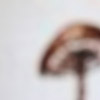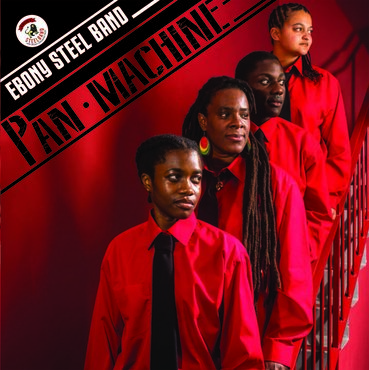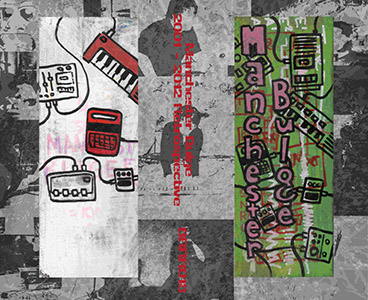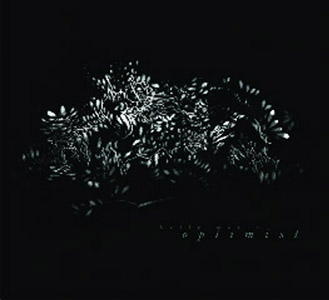- Administrator
- Albums and Singles
 Initially a work inspired by Cage's 100th birthday this year, this album began life as a soundtrack to his One11 film. However as those recordings progressed, Australian composer Lawrence English began to develop a wider body of pieces that were inspired, both directly and indirectly, by the legendary artist, and take on a life of their own.
Initially a work inspired by Cage's 100th birthday this year, this album began life as a soundtrack to his One11 film. However as those recordings progressed, Australian composer Lawrence English began to develop a wider body of pieces that were inspired, both directly and indirectly, by the legendary artist, and take on a life of their own.
Cage’s use of chance, and his interest in Zen Buddhism are among the more often occurring themes and influences on these eight pieces, which are deliberate and meditative, but retain a loose, improvisational feeling at times.The ghostly wisps and sustained lower-frequency moments of "Otidea Onotica" possess a certain peaceful quality, though that is contrasted by the quickly rising and falling tonal outbursts around them.
"Gymnosporangium" and "Amanita Inaurata" also have this apparition-like sparseness, with the former especially employing the varying tones and pitches of "Otidea Onotica"."Hygrophorous Russula" takes a different path, sounding like a slow-motion fall accompanied with higher register textural passages.
The back to back pieces "Naematoloma Sublateritium" and "Coprinus Comatus" make for an especially overt contrast, with the former relying on almost foghorn like dark sounds that go to a distinctly creepy, dark place, while the latter has a warmer, inviting character to it, even if they follow similar structures compositionally.
Closer "Entoloma Aborivum" stands out as perhaps the most drastically different piece on this album, given its harsher, more commanding tone.Even though it moves at a glacial pace, the heavily reverberated textures, at times resembling elongated guitar noise, are harsher and more commanding than what preceded it.The closing moments also have a shrill, feedback like quality that adds a bit of welcome abrasion to an otherwise gentle work.
For/Not For John Cage may show differing levels of inspiration courtesy of the legendary composer, but English's work also stands on its own as the work of a powerful, established artist in his own right.At times ascetically sparse, other times boisterous and dominating, there is a significant amount of variation within these eight pieces, but they all sit nicely beside one another as a coherent work.
samples:
 
Read More
- Administrator
- Albums and Singles
 Locrian has spent the better part of the last four years distinguishing themselves from the also-rans of the post-Sunn O))) drone scene, crafting their own distinct sound and identity amid many less engaging acts. While much of their recent work has been focused on the deconstruction of metal symbolism, paired with a more conventional rock bent, here the trio go back to their dissonant, abstract roots, with help from legendary audio and visual artist Christoph Heemann.
Locrian has spent the better part of the last four years distinguishing themselves from the also-rans of the post-Sunn O))) drone scene, crafting their own distinct sound and identity amid many less engaging acts. While much of their recent work has been focused on the deconstruction of metal symbolism, paired with a more conventional rock bent, here the trio go back to their dissonant, abstract roots, with help from legendary audio and visual artist Christoph Heemann.
On their most recent albums and collaborations, the trio of Terence Hannum, Andre Foisy and Steven Hess demonstrated a distinct turn in shaping the heavily treated synths and rapid guitar work into more traditionally song-like structures, without ever fully embracing conventionality.Here that is not quite as much of a noticeable feature, with the album divided into four 11 to 15 minute tracks that lead to longer, more experimental compositions.
Even the artwork shows some variance from the norm:the band’s penchant for using the signifiers of metal are all but gone, replaced by what more closely resembles a corrupted jpeg file.The sound, however, is clearly the work of Locrian, though the contributions from Heemann expand on their shared themes and approaches to sound.
"Hecatomb" is perhaps the most familiar sounding. The drums are notable but low in the mix, with electronic loops and acoustic guitar strums almost giving a Morricone like soundtrack vibe to the sound.The layers are piled on, each one more complex and intertwined with the one before, all the while generating an almost imperceptible melody hidden in the detritus.Eventually it focuses on the droning guitars and keyboards, feeling more in league with the earlier, more abstract Locrian works.
One characteristic Locrian has never traded in is the intentional, and usually overwrought, "evil" sound that other artists have embraced.Which is, I have always felt, a good idea.It helped them to develop their own identity without letting cliché overshadow content.However, on "Loath the Light," there is a horrifying sensibility via the crashing cymbals and bent synths, magnified by Hannum's tortured, guttural screams.Do not be mistaken: this does not come across as pseudo demonic high school metal bullshit.This is much more in league with Nature Unveiled/Dogs Blood Rising era Current 93, a hallmark of terrifying recordings, and transcends any corniness usually associated with such approaches.
The second half of the album is less visceral and more reflective, such as the layered guitar and propulsive low-end parts of "Edgeless City," which is by no means a lighter piece, but just feels dark, rather than overtly malignant."The Drowned Forest" takes on a more monastic feeling, with chanted vocals starting out as the focus, with a subtle amount of musical accompaniment that eventually peaks into a complicated wall of sound.There is no sense of movement or propulsion to be heard, it instead makes for a slowly decaying piece that just looms imposingly.
It is hard to tell where the separations are between Locrian's and Heemann's contributions, and that is one of the hallmarks of an effective collaboration.Neither artist seems to overshadow the other, but both retain their own identities perfectly, with Heemann's gloriously concrete tones and post-industrial chaos matching with Locrian's metal tinged guitar and electronic layers.Both artists step a bit out of their comfort zones on this album, and the result is a glorious success.
samples:
 
Read More
- Administrator
- Albums and Singles
 My life was never the same after hearing Fushitsusha for the first time. The second live album was a gargantuan asteroid of free rock headed straight for the center of my brain. The group has undergone many line-up changes and periods of inactivity but on this first album in about a decade, and the first since Yasushi Ozawa’s death in 2008, Keiji Haino is rejoined by Ikuro Takahashi on drums (Takahashi having previously filled the drum stool for Fushitsusha as well as other stalwarts of the Japanese psych scene like High Rise, Kousokuya, Aihiyo and LSD March) and by bassist Mitsuru Nasuno (a long-time collaborator with Otomo Yoshihide and former member of Ground Zero).
My life was never the same after hearing Fushitsusha for the first time. The second live album was a gargantuan asteroid of free rock headed straight for the center of my brain. The group has undergone many line-up changes and periods of inactivity but on this first album in about a decade, and the first since Yasushi Ozawa’s death in 2008, Keiji Haino is rejoined by Ikuro Takahashi on drums (Takahashi having previously filled the drum stool for Fushitsusha as well as other stalwarts of the Japanese psych scene like High Rise, Kousokuya, Aihiyo and LSD March) and by bassist Mitsuru Nasuno (a long-time collaborator with Otomo Yoshihide and former member of Ground Zero).
It was Nasuno’s other band with Haino, Seijaku, that led to this new Fushitsusha as Haino felt that the energy and music created on their two 2010 albums was very similar to the elements that made Fushitsusha what it was. Indeed, Seijaku’s Mail from Fushitsusha made the point incredibly clear (especially considering the usual obliqueness of Haino’s titles). Picking up the baton from where Seijaku left off, this sounds less like the Fushitsusha of It Was Eternity That Reached Out First or Origin’s Hesitation than expected; those looking for something like the first two live albums will be scratching their heads (though they can look to Haino’s new group Nazoranai for satisfying that urge).
There is a bright, early rock’n’roll feel to a lot of the rhythms so it is probably no coincidence that Fushitsusha have dropped the black artwork and gone for a cheery blue-green colour scheme on the sleeve. These short songs have something akin to a structure in most of them and a style that has shades of Les Rallizes Dénudés about it. Hikari to Nazukeyo clips along with the trio firing out intense, almost danceable pieces. On the fourth track (no English translations are given for the song titles), Haino comes as close to conventional playing as he has ever come while Takahashi and Nasuno punch out a solid rhythm; it sounds like something that might have been cast away by The Rolling Stones for being a bit too loose.
Although there is no fear of Fushitsusha becoming a pop band, both the opening and fifth piece provide ample opportunities for the group to flex those muscles. The first has a frenetic and uncomfortable rhythm that creates an air of mania whereas the fifth is an intense exploration of guitar feedback and heavy drumming. Towards the end of this latter piece, Haino goes off on an extended guitar solo where he hits every note bar the one I expect. The album finishes with all three musicians unleashing the full fury of their instruments to create a perfect storm of noise. This is music felt in the chest.
While Haino is obviously the most notorious member of the group, especially as later Fushitsusha albums felt more and more like his solo outings with extra musicians, this album demonstrates that the group is more than just a prop for him to show off his guitar playing. This new Fushitsusha play with a unity that makes it very difficult to think of them as anything less than a three-headed organism in its own right. Hopefully they will not call it quits again in the near future!
 
samples:
 
Read More
- Administrator
- Albums and Singles
 While 2010's excellent Endless Fall was a bit of a curve-ball, Scott Morgan has historically not been a man prone to surprises or grand gestures.  As a result, Sketches from New Brighton sounds almost exactly like I would expect a new Loscil album to sound.  There are certainly some minor evolutions and thematic changes, but Morgan is more or less covering very familiar territory once again (lush, pulsing, aquatic-sounding soundscapes).  Fortunately, I am quite fond of that territory.
While 2010's excellent Endless Fall was a bit of a curve-ball, Scott Morgan has historically not been a man prone to surprises or grand gestures.  As a result, Sketches from New Brighton sounds almost exactly like I would expect a new Loscil album to sound.  There are certainly some minor evolutions and thematic changes, but Morgan is more or less covering very familiar territory once again (lush, pulsing, aquatic-sounding soundscapes).  Fortunately, I am quite fond of that territory.
As alluded to by its title, Sketches from New Brighton falls within Loscil's series of works inspired by specific places.  The place in this instance is an ocean-side park in Vancouver bordered by factories.  It is easy to see how the collision of seemingly infinite natural majesty and dreary dystopian industrial sprawl could be inspiring, but it is hard to tell how much of New Brighton's character is actually reflected in the music because changes in Loscil's sound tend to be so subtle.  That said, Morgan's pace and textural leanings seem very much akin to drifting smoke and gently washing waves, as Sketches is essentially a series of languorous, artfully blurred swells unfolded with hypnotic repetition. Despite that, the nine pieces here have a structure and an approach that sets them a bit apart from most ambient music–they sound a lot more like '90 Mille Plateaux-style dub techno and Oval-style skipping CD loops liquified and purged of all beats and harshness.
Kranky's description of this album uses the amusing phrase "aural Feng Shui" to describe Morgan's aesthetic and it is difficult to think of a better way to describe what he has accomplished.  There are not any real hooks to speak of, nor are there any infectious rhythms or overt distinctions between the various pieces, but the album is nevertheless a very immersive, deliberate, and evocative whole without a misstep or wasted note.Although Scott has unarguably chosen very narrow stylistic terrain to work within, his minimalism affords him the ability to focus his near-obsessive attention upon every single aspect of his work.  As a result, Sketches from New Brighton is an absolutely beautiful piece of craftsmanship, production. and composition: deep sub bass, fragilely shimmering and quivering synths, quietly insistent pulses, subtly melancholy melodic coloration, spaciousness, small-scale vibrancy and unpredictability, etc.  Morgan does not miss a single detail.
It is pretty hard to rank Sketches from New Brighton within the Loscil oeuvre, as some of Morgan's other efforts offer a lot more in the way of instant appeal (grooves, broader textures, stronger melodies).This is easily as satisfying as anything else that Scott has done, however. He may have become narrower and more subtle, but he has also gone deeper.  As a result, Sketches is something of a step forward artistically, but a step backwards in accessibility and immediacy.  That is fine by me (this is not pop music, after all)–it just means that I will only reach for this album when I am in the mood for more focused and active listening.  Sketches from New Brighton is unquestionably yet another fine album from Scott, but it takes a bit more attention and effort to fully appreciate than usual.
Read More
- Administrator
- Albums and Singles
Industrial Records is proud to announce the much anticipated TWO album release:
DESERTSHORE / THE FINAL REPORT, a unique collaboration by Chris Carter, Peter 'Sleazy' Christopherson and Cosey Fanni Tutti. This is a two album release celebrating both the progress inherent in change and the fulfillment of two exceptional, yet separate projects. Available from 26th November 2012

‘Desertshore’
The ‘Desertshore’ project is a 're-imagined' cover version of Nico’s seminal 1970 album first conceived by the late Peter 'Sleazy' Christopherson in Berlin 2006. In 2010 at his home in Bangkok, he refocussed his approach readying to record guest vocalists while Chris and Cosey prepared material in their UK studio for his return there in December. Sadly, Sleazy unexpectedly died in his sleep on the 25th November in Bangkok.
Chris and Cosey made a commitment to Sleazy to complete the ‘Desertshore’ project picking up from where they left off just prior to his untimely passing. With enthusiastic support and contributions from so many who were close to Sleazy, especially the guest artistes whose work he admired; Antony, Marc Almond, Blixa Bargeld, Sasha Grey and Gaspar Noé, the project is now complete.
"a quite remarkable set of songs, a repurposing of Nico's maudlin, scraping sorrow into the deep mindmassaging
electronics that characterised later live work by Throbbing Gristle, X-TG and Carter Tutti,arguably even Coil's
Ape Of Naples."
Luke Turner for The Quietus as part of a review of a live remix preview performance of 'Desertshore' at AV Festival 2012.
‘The Final Report’
Throughout their 36 year friendship Chris Carter, Peter 'Sleazy' Christopherson and Cosey Fanni Tutti produced many pioneering and acclaimed collaborative works together.
These trio sessions were without exception always very productive; ideas that produced many hours of recordings, sound experiments, research in new performance possibilities, visuals, the ongoing design and building of new and innovative instruments; a constant restless exploration of new paths together.
‘The Final Report’ album has been completed from their final 2009/2010 sessions together at Chris and Cosey's studio in Norfolk. This album stands as the final report; a celebration, a loving remembrance of their unique partnership.
Industrial Records Ltd are proud to release these TWO extraordinary recordings.

'DESERTSHORE'
Janitor Of Lunacy - Vocals by Antony
Abschied - Vocals by Blixa Bargeld
Afraid - Vocals by Sasha Grey
The Falconer - Vocals by Marc Almond
All That Is My Own - Vocals by Cosey Fanni Tutti
Mutterlein - Vocals by Blixa Bargeld
Le Petit Chevalier - Vocals by Gaspar Noé
My Only Child - Vocals by Cosey Fanni Tutti
Desertshores - Various
‘THE FINAL REPORT’
Stasis
E.H.S.
Breach
Um Dum Dom
Trope
What He Said
In Accord
Gordian Knot
Emerge To Space Jazz
The End
Double Vinyl - Gatefold cover with 12" booklet.
Double CD - in bespoke CD packaging, 12 page booklet, postcard & bonus track.
Digital Download - with pdf booklet and bonus track. - aac, mp3, flac etc.
The album will be available worldwide from all the usual online & physical retail outlets,
including the Industrial Records web store.
More details to follow...
Read More
 Ebony Steel Band are a primarily eleven-person group of Trindadian and Caribbean musicians most well-known for paying tribute to other bands. Not to pay disservice to their original works, as they have produced Steel Away! (1976), Best of Steeldrums (1990), and Carnival (1998), but still, no one can deny their ability to breathe new life into classic songs. After their tribute to The Beatles with 2010's Popular Beatles Songs - Caribbean SteelDrums, director Ian Shirley challenged EBS to cover Kraftwerk, one of the most classic and enduring pioneers of electronic music in history. Their effort was a complete success.
Ebony Steel Band are a primarily eleven-person group of Trindadian and Caribbean musicians most well-known for paying tribute to other bands. Not to pay disservice to their original works, as they have produced Steel Away! (1976), Best of Steeldrums (1990), and Carnival (1998), but still, no one can deny their ability to breathe new life into classic songs. After their tribute to The Beatles with 2010's Popular Beatles Songs - Caribbean SteelDrums, director Ian Shirley challenged EBS to cover Kraftwerk, one of the most classic and enduring pioneers of electronic music in history. Their effort was a complete success.
- Administrator
- Albums and Singles
LINKS:
More information on Christoph Heemaan: http://brainwashed.com/common/htdocs/biog/heemannc.php?site=mimir
Read More
- Administrator
- Albums and Singles
 It seems like any American city (or even large-ish town) has at least one local noise band. Perhaps it is the ubiquity of the Internet or a handful of Wolf Eyes and Merzbow albums that received some significant hype and distribution, but what was once a style that was baffling to most is on par with punk or hardcore as far as local representation goes. Manchester Bulge, hailing from Fargo, North Dakota, preceded this American noise band explosion (or sloppy outburst, depending on perspective) though, dating back to 2001. This collections captures a band at the forefront of what somehow managed to become a scene and makes for an excellent window into one town’s premiere noise project.
It seems like any American city (or even large-ish town) has at least one local noise band. Perhaps it is the ubiquity of the Internet or a handful of Wolf Eyes and Merzbow albums that received some significant hype and distribution, but what was once a style that was baffling to most is on par with punk or hardcore as far as local representation goes. Manchester Bulge, hailing from Fargo, North Dakota, preceded this American noise band explosion (or sloppy outburst, depending on perspective) though, dating back to 2001. This collections captures a band at the forefront of what somehow managed to become a scene and makes for an excellent window into one town’s premiere noise project.
Admittedly, for something that covers a span of just over a decade, the sense of organization or structure to 2001-2012 Retrospective is confounding at best.There is no clear timeline of when these various pieces were recorded, and the titles themselves are ambiguous to say the least. The small included booklet does give some insight into the project overall and features some nice photography, but it is best to take things in at face value rather than look for a deeper underlying concept.
Most of the material spread across these three tapes was captured live, and that definitely shows.Dying tape motors and wobbling electronics give "Tromittar" a fun, haunted house vibe that is furthered by an indistinct far off clatter and the occasional monstrous growl.Everything stays mired in an appropriately low fidelity murk and, even with some melodies rising up near the end, it continues to sound more than just a bit off."MB Track 1 PT2" continues with the ghostly feel, with clanging synth stabs cutting through bent synth string passages.
Other facets of Manchester Bulge's sound are a bit looser and less bleak in nature.Sputtering sounds, toy piano, and bursting electronics define most of "Barn" in a simple, yet pleasant outburst of noise."10/8 MB12" is another shambling mélange of sound:stuttering noises and mangled computer data tapes set the stage for something that sounds like a keyboard found in the forgotten backroom of a Goodwill warehouse, covered in cobwebs and spider eggs,but somehow manages to still work and therefore is a viable instrument for Manchester Bulge.
The third tape in this set is the one that comes across as the strongest and most focused, however.Toy organ tones and jackhammer like electronics end up making "Upfront" almost melodic in some sort of twisted way, with a nice psychedelic edge to it.Both "Meth Lab" and "MB2" feature Manchester Bulge working with tapes, via erratic sputters, backward noises, and wobbling pitches and tones.The latter also excels with a bit of banging metal and shimmering, nervous electronics at its end.The flip side of the tape excels with "MB Live Raven", with its opening of a noise standby:the buzz and feedback of what sounds like a bass amp.Even with the harsher sounds used, there is a nice sense of space throughout, allowing all of the elements to shine, even if they are buzzing, brittle electronics that sound about to fail at any time.It builds to an almost prog rock climax of harshness and depth before collapsing wonderfully.
I have always been a fan of these sorts of releases.Having never been to North Dakota and, if I had, I would likely not be going to some small noise house show; this collection gives me an almost ethnographic overview of such a scene.Manchester Bulge's is Fargo's longest running noise project and, while different than ones I have encountered, it features that same universal sense of experimentation and actual fun that can be had within such a band.As with any band doing this type of release, there are a handful of less engaging or meandering moments here and there, but, warts and all, it is a fascinating snapshot into the career of a local noise band.
Samples can be found here
Read More
- Administrator
- Albums and Singles
 There are a number of great labels unearthing and breathing new life into forgotten treasures these days, but it is truly rare for anyone to match Dust-to-Digital when it comes to presentation and sheer comprehensiveness. Each major release feels like an event years in the making, certain to send at least one circle of obsessive music fans scavenging for additional extant releases from an eclectic array of previously unknown or obscure artists. This latest opus is an especially big hit with me, collecting a remastered trove of '50s East and Central African rumba recordings by South African/English musicologist Hugh Tracey. I had no doubt that these recordings would be unique and historically important, but I was legitimately blindsided by how incredibly fun these songs can be, often resembling a raucous, inebriated, and Latin-tinged street party where everyone knows all the words to every song and nearly everyone seems to have inexplicably brought along a kazoo.
There are a number of great labels unearthing and breathing new life into forgotten treasures these days, but it is truly rare for anyone to match Dust-to-Digital when it comes to presentation and sheer comprehensiveness. Each major release feels like an event years in the making, certain to send at least one circle of obsessive music fans scavenging for additional extant releases from an eclectic array of previously unknown or obscure artists. This latest opus is an especially big hit with me, collecting a remastered trove of '50s East and Central African rumba recordings by South African/English musicologist Hugh Tracey. I had no doubt that these recordings would be unique and historically important, but I was legitimately blindsided by how incredibly fun these songs can be, often resembling a raucous, inebriated, and Latin-tinged street party where everyone knows all the words to every song and nearly everyone seems to have inexplicably brought along a kazoo.
Few, if any, Westerners can claim to have done as much to bring African music to the world as Hugh Tracey, as he founded the International Library of African Music (ILAM) and made twelve separate treks into sub-Saharan Africa to collect instruments and record local musicians.Based on the recollections of his wife Peggy in the accompanying booklet, these trips were often far from pleasant, as the bad roads, rugged accommodations, car breakdowns, and illnesses inherent in such an endeavor made it quite hard to enlist a willing team.Also, people were not exactly clamoring to join the Traceys in the first place, as being so far ahead of the curve was a lonely life: having an intense passion for African music in the early '50s branded Hugh as a "crank" or a "dreamer" in most respectable circles.Amusingly, he also later took flak from the other side, as more "serious" ethnomusicologists took issue with some of his recording/editing preferences and his "staging" of traditional performances.According to Peggy, the "jackals" from the record company (Gallo) also pressured Tracey to focus on the more marketable "town" or popular music scenes, whereas he was much more interested in indigenous/traditional fare.It would probably break Hugh's heart a bit to see that so much "town" music wound up on this collection, but the jackals were surprisingly prescient, as that buoyant mélange of styles has aged remarkably well.I am completely out of my depth in trying to identify and follow the various improbable threads that found their way into these songs, but the most prominent influences to my ears tend to be Latin American and Caribbean in nature, though Hawaiian, Indian, and Arab influences are sneakily rampant as well.
Unsurprisingly, "town" music is quite a wide category in the context of this album, as Tracey found significant differences in styles as he and his crew traveled from region to region.That variety is best illustrated by the three versions of a single song entitled "Nimepata Mpenzi, Mtoto Mdogo, Mzuri, Simwachi (I Got a Young, Beautiful Girl that I Won't Leave)" recorded in Tanganyika and Malawi.Notably, it is one of the album's finest songs, yet each version takes a very different direction despite adhering to roughly the same melody and lyrics.In the Dar es Salaam version, the piece is a lurching, percussion-heavy sing-a-long with a drunken-sounding central theme played on violin and kazoo.In the Mawanza version (my favorite), the central melody is a gorgeously bittersweet swirl of flutes that harmonize and intertwine sensually.Elsewhere, in Malawi, the piece sounds like it was performed by a mandolin-wielding mariachi band.As if to pointedly emphasize the beguiling eclecticism of '50s African rumba still further, that triptych is followed by "Chineno," a wonderful piece by Dar es Salaam ballroom dance ensemble Merry Black Birds that resembles some sort of Thai or Arabic surf oddity that I would expect to encounter as the centerpiece of a Sublime Frequencies collection.My favorite piece on the album comes from the Congo, however, as Coast Social Orchestra's "Nali Kisafiri" is a radiant and rolling delight that sounds like a classic New Orleans jazz standard enlivened with a healthy dose of Cuban percussion and highlife rhythm.
Listen All Around is not exclusively populated by lively dance ensembles of varying competence and ramshackleness, however, as compiler Alex Perullo peppers the collection with entertaining oddities and delightfully rough-edged performances from Tracey's vast archive of ILAM recordings.Three such highlights are "Soko Olingi Na-Boma (If You Want to Kill Me)," "Kwa Jinsi Ninavyokupenda (How I Love You)," and "Mangwasi."The latter, a "passionately sung love song by a young Tukuyu musician" is among the rawest and most endearingly unhinged-sounding pieces on the album, as the melody is delivered in wonderfully motor-mouthed and hammy fashion over some three-chord jangling guitar, arguably anticipating punk by at least two decades."If You Want to Kill Me" is fun in a very different way, unfolding as a similarly rapid-fire vocal performance, but bolstered by plenty of backing refrains, lively and clattering hand percussion, and whistled melodies that seem to amusingly wander in and out of tune.Lastly, "How I Love You" is one of the album's true masterpieces, resembling a tipsy and lurching Latin brass band parade trailed by a wake of celebrants adding their own embellishments of honking kazoos and clinking bottles.That is actually just what the amateur-populated Dar es Salaam jazz band sounded like normally, which only earns them a deeper place in my heart.More than anyone else on the album, that band of spirited amateurs captures both what makes Listen All Around such a great collection and why Tracey was so captivated by the sounds of the region: even the least polished ensembles feel like a vibrantly alive and rhythmically inventive collection of cross-cultural magpies with a singular intuition for taking the best parts of literally anything they have heard and seamlessly making it their own.A lot of newly reissued ethnomusicological finds from the 1950s and earlier feel more like school than entertainment or pulsing, unfiltered life to me, but Listen All Around is a truly wonderful exception.
Samples can be found here.
Read More
- Administrator
- Albums and Singles
 New York based composer and pianist Kelly Moran has been quickly developing a body of work that rich and complex with not just piano and electronics, but also her exceptional and nuanced approach to production and sound design as well. The instrumentation of Optimist may seem basic: all nine songs feature piano (prepared and unprepared) and some additional synthesizer and electronics, but the finished product has so much more depth than it would seem. It comes together as a fully realized, gorgeously diverse series of compositions.
New York based composer and pianist Kelly Moran has been quickly developing a body of work that rich and complex with not just piano and electronics, but also her exceptional and nuanced approach to production and sound design as well. The instrumentation of Optimist may seem basic: all nine songs feature piano (prepared and unprepared) and some additional synthesizer and electronics, but the finished product has so much more depth than it would seem. It comes together as a fully realized, gorgeously diverse series of compositions.
A number of these songs feature Moran leading the traditional sounding piano to the forefront, which is no surprise.The opening "Optimist" features the mostly pure piano sound, seemingly presented in interlocking loops, with additionally treated passages and plucked strings rounding out the piece into an understated, yet dynamic structure.Her playing on "Nyght Spel" is a bit more deliberate:harder, hammered sounding piano notes command attention, although presented in an overall pleasant sounding melodic framework, as additional electronics and synths flesh out the mix.
During other moments, the piano is there, but utilized less in its conventional sound.During "Strangers are Easy to Look at, Loved Ones are Museums of Brutality" (the perfect song title for the current holiday season), it is sparingly used, with infrequent notes dowsed in echo and reverb.Synthesizers and ebows are used to construct a glistening, icy wind that drifts through the mix.On "Let's Dance", Moran takes the sound of her piano into more lo-fi spaces; a hollow, thin sound that is still the instrument in question, but with a unique edge on it overall.More synthesizer layers are blended in to fill out the performance quite beautifully.
The sound is even more out there when "Glacial" comes around.Plucked strings instead take on the sound of tonal, gorgeous bells that chime out, and her ebow and synthesizer additions add a slightly grimy, almost distorted guitar-like patina to the otherwise pristine sounds.Moran employs the same tools to "Dream Pauline" with notably different results.In this case, there is a dynamic, up-tempo flow to the composition, and besides the conventional sounding piano she also blends in lush, droning tones and an almost harpsichord-like sound from her treated piano.The final product is a faster, more rapidly flowing piece that wonderfully contrasts the more pensive, delicate moments of the record.
Like her other albums, Optimist is solely the work of Kelly Moran:composition, performance, recording, and production.While obviously demonstrating immense talent and skill on her part, it also has a positive impact when it comes to the final product.These compositions clearly demonstrate the singular focus she has on her art, and also what can be achieved when an artist is able to exert complete control.In some scenarios this could lead to a bloated, self-indulgent piece of music, but Optimist is anything but.Instead it is diverse, varied album of beautiful sounds that demonstrates a multitude of dynamics, but all unquestioningly linked by Moran’s hand.
Read More
- Administrator
- Albums and Singles

Artist: Hirsute Pursuit feat. Boyd Rice
Title: Boyd Keeps Swinging
Catalogue No: CSR157EP
Barcode: 8 2356650662 1
Format: 12" in full colour glossy sleeve
Genre: Gay / Industrial / Techno / Electronica
Shipping: Now
Man To Man Electronic Sex Music. This 12” vinyl features 6 remixes of the David Bowie song, ‘Boys Keep Swinging’, with guest vocalist Boyd Rice (NON), who also stars in the music video.
A veritable “who’s who” of musicians / remixers give the track a dancefloor makeover, from grinding Industrial to hard techno: ALAN GREGORIE (Depeche Mode, The Cure, Cyndi Lauper), DEREK RUSH (Dream Into Dust, Compactor, A Murder Of Angels), BRYIN DALL (Thee Majesty, 4th Sign of the Apocalypse), RAE DILEO (Henry Rollins, Filter), MC Spacebar (Hirsute Pursuit, Loretta’s Doll), EDLEY O’DOWD (PTV3, The Toilet Boys, Tony Conrad).
Limited edition vinyl with provocative artwork by Syluss Fortay.
Tracks: A1. Boys Keep Swinging (Los Ninos De Amor Mix) - Alan Gregorie | A2. Boys Keep Swinging (Boys Club Mix) - Derek Rush | A3. Boys Keep Swinging (Uniform Mix Mix) - Bryin Dall | B1. Boys Keep Swinging (Blade Kraft Mix) - Rae Dileo | B2. Boys Keep Swinging (A Little Bit Dirty Mix) - MC Spacebar | B3. Boys Keep Swinging (Boodle Boy Mix) - Bryin Dall & Edley ODowd
Read More


